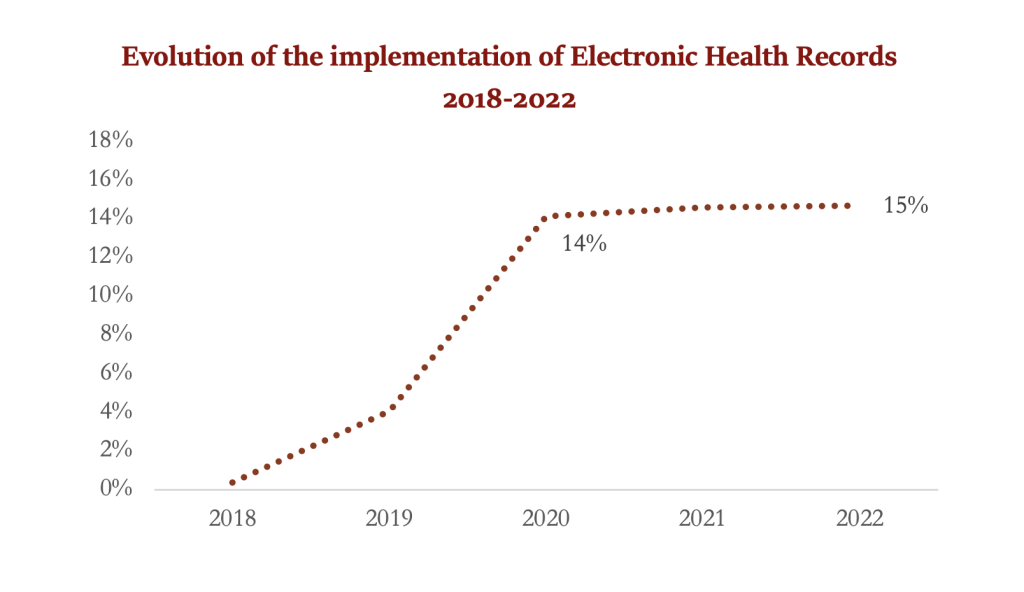 2020. Composición de imágenes de personas en trajes de protección en Lima, Perú, ciudad impactada fuertemente por la COVID19, durante los tiempos de pandemia.
2020. Composición de imágenes de personas en trajes de protección en Lima, Perú, ciudad impactada fuertemente por la COVID19, durante los tiempos de pandemia.
Two years ago, in Motupe (Peru), Doña Rosa (69) desperately sought a diagnosis for her chest pain. She visited local health posts but did not get clear answers. She undertook a quest for appropriate care, first in Lambayeque and, finally, in Lima. Along the way, she faced unnecessary expenses for transportation, lodging, and medical analyses. The new health establishments did not recognize the previous test results, and some were even lost. After 11 months and significant expenses, Doña Rosa was finally diagnosed with type 2 diabetes.
The fragmentation and poor organization of the health system in Peru is just one of the many challenges that the sector and the population face. The experience of Doña Rosa and millions of Peruvians would benefit transversally from implementing a Health Information Management System (HIMS). It would allow for better quality of care and improve the decision-making of health professionals and health authorities. Here's how a Health Information Management System would help.
1. What is a Health Information Management System?
A Health Information Management System is a set of standards, infrastructure, and governance that produce and organize health data to optimize the management and use of health information. An adequate Health Information Management System must value the large and varied information produced by a health system to strengthen decisions for governance and service delivery, as well as to optimize the experience and services from the users' point of view.
2. How would a Health Information Management System in Peru help?
Such a system would make it possible to use information as a tool for better healthcare delivery. For example:
- Standardized reporting would allow national monitoring of diseases, productivity of health personnel, and transition of patients between subsectors.
- A record of information on the quality and effectiveness of care would allow the Ministry of Finance to incentivize improvements across the sector through performance-based budget allocation.
- Monitor the shortage of human resources and inputs, which could be solved through redistribution based on real-time information, avoiding mismatches with local demand.
3. What is the current situation of the Health Information Management System in Peru?
Although the Ministry of Health (MINSA) recognizes the usefulness of a Health Information Management System and has promoted legislation for the standardization of data in the sector since 2005, after more than 20 years, 74 regulations, and 300 digital applications in health, the country has not yet achieved the objective. For example, the implementation of Electronic Health Records reached 15% of health facilities in 2020 and has not advanced , as seen in the graph below.

4. What are the World Bank and Peru doing about it?
To understand the challenges that impede the consolidation of a Health Information Management System in the country and to propose some recommendations, the World Bank conducted an exhaustive investigation where more than 20 years of regulations were reviewed, more than 30 experts and officials were interviewed, and more than 50 subnational health information systems officers were surveyed. The answers are detailed in the "Health Information Management Systems in Peru" report (in Spanish).
5. What are the report's main recommendations?
- Expand connectivity for the last mile. Only one-third of health facilities have internet access. Active intervention by the public sector is necessary.
- Establishing an Information Analytics and Management Unit (UAGI) would allow information to be recorded in an integrated way and not segmented by topics, providing answers to multidimensional problems and facilitating decision-making.
- Adapting Human Resources to the Health Information Management System is essential to address the work overload of health personnel and improve the quality of information registration through training.
- Strengthen governance: Frequent direction changes and lack of synergies between key actors do not help. A Secretariat for Governance in the MINSA would oversee a strategy with consolidated regulation and spaces for intersectoral, territorial, and strategic sector coordination.
The reform proposals are of great magnitude, as is the importance of implementing a HIMS to boost the health sector in Peru. The diagnostic and recommendations for implementation are only the starting point.
We invite you to review the report (in Spanish) to better understand the challenges and opportunities that Peru has in implementing its HIMS, as well as to reflect on lessons that can be used by other countries on the same route.
Stay updated with our weekly article
Related articles


Join the Conversation